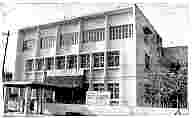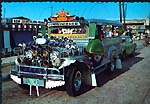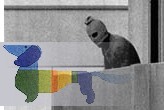"A TRIP DOWN MEMORY LANE" |
PPart 1
I can still remember the first day of high school in June of 1972. It was chaotic and confusing, as each one of us fought our way to a list posted on the building wall that showed which "section" or class one will be in. The incoming freshmen were divided into 15 sections. I was disappointed that I was the only one from my elementary school in Bayan Luma who was assigned to Section 2, as three of my good friends were assigned to Section 1 - Edgardo Sarroca, Felicismo Aranzazu and my best buddy, Alex "Bibing" Camungol. Students were assigned to different sections depending on the intelligence level, from Section 1 with the smartest kids (most of them honor students in their elementary schools), to Section 15, who had the worst of the underachievers. To this day, I think that it is not a good idea because this system penalizes those who were not born smart. This arrangement, prejudiced, as it may seem, has been going on for decades though, and was never an issue. It took a few days for me to adjust to my new environment. I got to know all my teachers and made new friends, among them Angel Abad and Juancho Lucas, whom I met on the very first day. They were really cool guys. I started hanging out with Imus Pilot Elementary School graduates Percival Jarin, Luisito Dominguez, Virgilio Oreste, Genaro de Quiroz and Ramir Kamantigue. I still remember my Pilipino and GMRC (Good Manners & Right Conduct, remember?) classes with Mrs. Elenita Monzon, but the most unforgettable for me was my General Science class under Mrs. Epifania de Castro, still very vivid in my memory after all these years. A few days before a monthly examination, I was approached by a friend from the lowest section with a copy, or "leakage", of the General Science test paper that he got from somebody. I did not refuse his request to work on the solutions, I even got my best friend, Bibing, to help us out. Needless to say, the test was very easy for Bibing and myself, but to avoid suspicion, we deliberately made a few mistakes. A few days after the test, Bibing warned me that Mrs. de Castro will soon be talking to me, as she had already found out about us! I was shaking with fear when she asked me to stay after class. To my surprise, she had a smile on her face when she told me how she found out. This friend of mine who was the source of the test paper got too lazy to make a mistake, he perfected the exam. He even shared it with a cousin who also got a very high grade. She got suspicious because the two of them were very unlikely to get very high scores, they have the same last name and were both from Bayan Luma. After confronting the two of them, they admitted they had the test paper ahead of time and pointed to us as accessories! Mrs. de Castro was kind enough not to suspend us, but only had the four of us take the examination again. I forgot how I did. I was just happy to pass her class. For most of us, going to and from
school means commuting by jeepney or tricycle if you were from a barrio, or by walking, if
you lived close to the school. If you were from Bayan Luma, you probably rode with
Mang Kuring’s colorful jeepney or if from Bukandala, with Mang Ugok (really funny
because "Mang" is a word of respect and the second word is you know
what!). Those from Binakayan and Medicion most likely took Leonardo Nievera’s
father’s 1972 was the year of the Munich
Olympic Games, which will be forever remembered as the quadrennial event when 11 Israeli
athletes were murdered by Arab terrorists. For basketball-crazy Filipinos,
this was the last time they saw a On September 21, 1972, martial law was declared by then-president Ferdinand Marcos through Proclamation 1081. His enemies, branded as subversives, were thrown in jail, many of them, to spend years of incarceration if lucky enough to come out alive. There were no classes on the next several days, no TV, radio nor newspapers. When order was restored, the general population seemed to be in their best behavior. Curfew was enforced and violators spent the night in a military camp. I'm sure that most of you will remember the government slogan, "Sa ikauunlad ng bayan, disiplina ang kailangan." TV personality Ariel Ureta spent a few days at a military stockade for making fun of it, when he used the word "bisikleta" instead of "disiplina". Limited TV and radio broadcasts, as well as newspapers resumed their services later but were strictly controlled by the government. Nora Aunor and Vilma Santos were at the height of their rivalry. I refuse to disclose if I was a Noranian or a Vilmanian. Ramon Revilla, an Imus native, was just starting his string of "anting-anting" movies. He scored a big hit with "Nardong Putik", supposedly a true-to-life Robin Hood story of a Caviteņo hoodlum named Leonardo Manecio, who several months before was killed in a shootout with lawmen. No matter that a big chunk of the screenplay, especially Nardo's "anting-anting", was make-believe, but with cameo appearances from stars of the day like Dolphy and Panchito, the movie was a blockbuster that resurrected Revilla's career. |
 Selecting
which high school to go to was not a difficult task – there were only two in town, it
was either Imus Institute (II) or Del Pilar Academy (delPA). If a parent or your
older siblings went to one of these schools, chances are you will be going to the same
school. My three sisters and a brother all went to II and that was how I ended up in
this school. The next four years, I was wearing the school uniform, dark blue pants
and white shirt with the school patch in the chest pocket, to join the girls in their
white skirt and blouse with a dark blue tie embroidered with the letters
"II". This school patch became the subject of Mr. Rait's (the school
security guard) daily inspection at the front gate. No patch, no entry.
Selecting
which high school to go to was not a difficult task – there were only two in town, it
was either Imus Institute (II) or Del Pilar Academy (delPA). If a parent or your
older siblings went to one of these schools, chances are you will be going to the same
school. My three sisters and a brother all went to II and that was how I ended up in
this school. The next four years, I was wearing the school uniform, dark blue pants
and white shirt with the school patch in the chest pocket, to join the girls in their
white skirt and blouse with a dark blue tie embroidered with the letters
"II". This school patch became the subject of Mr. Rait's (the school
security guard) daily inspection at the front gate. No patch, no entry. jeepney. Those living at Justinville Subdivision
in Bacoor had their own jeepney service. A jeepney overloaded with students was a
common sight. I remember sitting in Mang Kuring’s jeepney’s front seat
with him and five other kids! To make matters worse, four, sometimes five other boys
were "sabit" in the back of the jeep. These boys knew their manners on how
to be a "Boy Scout", which means giving up your seat to a girl. To keep us
entertained on the drive home, we listened to our favorite tunes on his 8-track tape
player – a custom made "selection" pirated by Emil, a guy from Medicion
whose business was to make unauthorized copies of records. These recordings can be
tailored to anybody's taste, so if one prefers more treble than base, this is what he
gets. With that and a colorful, fancy calligraphy for a label, they sold at around
P20 each in the early '70s. Jeepney drivers with a big collection of these 8-track
tapes would stack them just above the dashboard and halfway up the windshield, and
covering its entire length. He had to stick out his head forward to have a better
view of the road. To further hamper visibility, better decorated jeepneys were
adorned with several stainless steel horses and plenty of useless side view mirrors in
jeepney. Those living at Justinville Subdivision
in Bacoor had their own jeepney service. A jeepney overloaded with students was a
common sight. I remember sitting in Mang Kuring’s jeepney’s front seat
with him and five other kids! To make matters worse, four, sometimes five other boys
were "sabit" in the back of the jeep. These boys knew their manners on how
to be a "Boy Scout", which means giving up your seat to a girl. To keep us
entertained on the drive home, we listened to our favorite tunes on his 8-track tape
player – a custom made "selection" pirated by Emil, a guy from Medicion
whose business was to make unauthorized copies of records. These recordings can be
tailored to anybody's taste, so if one prefers more treble than base, this is what he
gets. With that and a colorful, fancy calligraphy for a label, they sold at around
P20 each in the early '70s. Jeepney drivers with a big collection of these 8-track
tapes would stack them just above the dashboard and halfway up the windshield, and
covering its entire length. He had to stick out his head forward to have a better
view of the road. To further hamper visibility, better decorated jeepneys were
adorned with several stainless steel horses and plenty of useless side view mirrors in  the hood! No wonder some jeepneys have an altar in the
front or a painting of Jesus in the ceiling with the words "God Bless Our Trip"
- with those compromises on safety, one would definitely need a prayer to reach his
destination! If the passengers were all boys, Mang Kuring would sometimes play those
lewd but funny Big 3 Sullivans songs, otherwise he would play the pop songs of the day,
like The Carpenters’ "Top of the World" or any of Stevie Wonder’s many
hits. Other popular tunes were Don McLean's "American Pie" and The
Stylistics' "Betcha By Golly, Wow". On the local scene, Pinoy rock was
starting to have its own followers with the success of the Juan de la Cruz Band.
They revolutionized Filipino music by blending Tagalog lyrics with their original rock
tunes. Their "Himig Natin" became a Pinoy rock anthem and would be an
inspiration to future generations of Pinoy rock musicians.
the hood! No wonder some jeepneys have an altar in the
front or a painting of Jesus in the ceiling with the words "God Bless Our Trip"
- with those compromises on safety, one would definitely need a prayer to reach his
destination! If the passengers were all boys, Mang Kuring would sometimes play those
lewd but funny Big 3 Sullivans songs, otherwise he would play the pop songs of the day,
like The Carpenters’ "Top of the World" or any of Stevie Wonder’s many
hits. Other popular tunes were Don McLean's "American Pie" and The
Stylistics' "Betcha By Golly, Wow". On the local scene, Pinoy rock was
starting to have its own followers with the success of the Juan de la Cruz Band.
They revolutionized Filipino music by blending Tagalog lyrics with their original rock
tunes. Their "Himig Natin" became a Pinoy rock anthem and would be an
inspiration to future generations of Pinoy rock musicians.  Philippine Olympic basketball team. Together with
Japan, they were the Asian representatives. They beat Japan in their Olympic
encounter. The Japanese were led by guard Shigeaki Abe and 6'8" center, Hirofumi Numata.
It was before the decline of Philippine basketball, before China rejoined the Asian
basketball circuit and before most of Asia caught up with Filipinos in basketball
talent. Their only serious opponents then were the Japanese and the Koreans, who had
the legendary Shin Dong Pa. This Olympic team had my favorite player, Freddie Webb,
and three of his teammates from my favorite team, the Yco Painters. One of the most
popular Pinoy hoopster ever, Robert Jaworski, was not on this team. He and
Meralco teammate, Alberto "Big Boy" Reynoso, were earlier banned for life from
playing basketball for beating up both referees during a game. Because we lived in a
very forgiving society, the ban was eventually lifted and both players resumed their
playing careers. USSR won the gold medal against the United States in a
controversial final game, the first time that an American team was beaten in an Olympic
competition. The Americans protested, but lost, and then refused to receive their
silver medals in the awards ceremony.
Philippine Olympic basketball team. Together with
Japan, they were the Asian representatives. They beat Japan in their Olympic
encounter. The Japanese were led by guard Shigeaki Abe and 6'8" center, Hirofumi Numata.
It was before the decline of Philippine basketball, before China rejoined the Asian
basketball circuit and before most of Asia caught up with Filipinos in basketball
talent. Their only serious opponents then were the Japanese and the Koreans, who had
the legendary Shin Dong Pa. This Olympic team had my favorite player, Freddie Webb,
and three of his teammates from my favorite team, the Yco Painters. One of the most
popular Pinoy hoopster ever, Robert Jaworski, was not on this team. He and
Meralco teammate, Alberto "Big Boy" Reynoso, were earlier banned for life from
playing basketball for beating up both referees during a game. Because we lived in a
very forgiving society, the ban was eventually lifted and both players resumed their
playing careers. USSR won the gold medal against the United States in a
controversial final game, the first time that an American team was beaten in an Olympic
competition. The Americans protested, but lost, and then refused to receive their
silver medals in the awards ceremony.